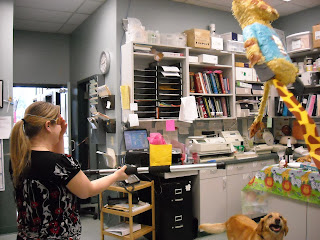
I walked into the hospital this morning to be greeted by streamers and lime green (my favorite color) balloons, banners, even a pinata. My Birthday is in a few days, and my wonderful staff is spoiling me rotten today-aren't I lucky? They out do themselves every year-all the lions and giraffes and zebras are terrific-very festive and just right for the veterinary hospital. I love that they are all working together for me, as they always do.
 Winston came in this morning and sure didn't seem too worried about all the decorations. He was wiggling and bouncing, much happier than his owner saw him acting yesterday when she was so concerned for him. He had been lethargic, not eating, feverish, vomiting-a pretty sick Rat Terrier. Those little guys are always busy, happy things-so this was very worrisome. We asked some questions of his owner and found out that right before he got sick, she fed him some raw chicken-very likely the culprit.
Winston came in this morning and sure didn't seem too worried about all the decorations. He was wiggling and bouncing, much happier than his owner saw him acting yesterday when she was so concerned for him. He had been lethargic, not eating, feverish, vomiting-a pretty sick Rat Terrier. Those little guys are always busy, happy things-so this was very worrisome. We asked some questions of his owner and found out that right before he got sick, she fed him some raw chicken-very likely the culprit.Even though Winston has been getting raw meat about once a week throughout his life, it only takes one time like this for an owner to really understand the potential dangers of feeding raw diets. Many breeders will hail the benefits, always coming back to "wild" animals and their raw diets being so beneficial to them-better hair coats, maintaining weight, better immunity-the list goes on and on. If there is an ailment, raw diets have been reported to be the cure-all. But we know that like any food, balance is the key. Raw diets may have their place, but often are fed by people who don't understand the concept or don't take the proper precautions-and the pets pay the price.
The fact is, dogs aren't closely related to wild animals at all. They have been domesticated for some 50,000 years! Their digestive systems have evolved beyond that of a coyote or wolf, so comparing them really isn't accurate. While it is possible to feed raw diets in a healthy manner, it is expensive and very time consuming to do so. Consulting with a veterinary nutritionist is essential to determine your individual pet's requirements-it isn't enough to throw some meat and veggies and rice in a blender and call it good.
There are some very real risks to feeding raw diets-and I have seen and treated all of these, including Winston's likely case of gastritis/enteritis. Perforation of any part of the GI system from the bones fed in raw diets is immediately dangerous. I have also seen impactions of bone material when it has been properly chewed up but accumulates in a tubular organ. Broken teeth from the very hard bones is also a risk, no matter how beneficial they may be at cleaning the teeth. These problems may be minimized if the bone is ground up in a blender before feeding.
Nutritional inadequacy is very common, as I mentioned. Osteodystrophy and rickets can occur when diets aren't balanced. There is at least one raw diet that has undergone AAFCO feeding trials, Nature's Variety Instinct, so this can just be purchased and fed as a complete raw diet. If people are set on preparing their own food, consulting with nutritionists at veterinary teaching hospitals or through websites like: www.monicasegal.com and www.balanceIt.com who offer information about raw and home made diets.
The other main concern about raw diets is the contamination with pathogens. This shouldn't be a huge problem in otherwise healthy dogs or cats, but can be an issue in very young, very old or immunosuppressed animals-and people. Don't forget the risk to the humans preparing the food. A relatively unscientific survey by Consumer Reports of grocery chicken showed 80% contamination with Campylobacter, and about 15% with Salmonella - organic and free range were worse in this survey. E. coli is ever-present as well. We have many researched journal articles that support this concern too. So, just the public health issue is enough to make this way of feeding undesirable-simply cooking the ingredients eliminates the pathogens.
 You would think that the treatment for exposure to bacteria would be antibiotics, but not in Winston's case. He was actually suffering from a condition caused from the death of those bacteria and the subsequent release of the toxins they produce upon dying. This is called endotoxemia or endotoxic shock in severe cases. Killing off more bacteria could result in worsening of the condition. We instead treat with lots of fluids and some medicine that is anti-endotoxin if needed. Since he really was improving over just last night, we decided to treat him as an out patient and have his owner monitor him at home. We loaded him up with some subcutaneous fluids (SQ fluids)-allowing them to absorb through the small blood vessels called capillaries in the fatty tissues under the skin. His owner will likely forgo the raw meats in the future and instead will likely cook any extra meats she offers him-just to be safe.
You would think that the treatment for exposure to bacteria would be antibiotics, but not in Winston's case. He was actually suffering from a condition caused from the death of those bacteria and the subsequent release of the toxins they produce upon dying. This is called endotoxemia or endotoxic shock in severe cases. Killing off more bacteria could result in worsening of the condition. We instead treat with lots of fluids and some medicine that is anti-endotoxin if needed. Since he really was improving over just last night, we decided to treat him as an out patient and have his owner monitor him at home. We loaded him up with some subcutaneous fluids (SQ fluids)-allowing them to absorb through the small blood vessels called capillaries in the fatty tissues under the skin. His owner will likely forgo the raw meats in the future and instead will likely cook any extra meats she offers him-just to be safe.It is true that many toxicities have occured from traditional commercial diets due to contamination and dangerous additives-so they aren't guaranteed for safety. Still, they are less risky over all and generally the better choice for busy people who just want the best for their pets.

 More surprises awaited me at lunch time-my crazy, wonderful staff decorated the treatment area with more jungle attire and laid out a huge meal for all to share. They gave me a sweet jungle animal card with some VERY generous gift certificates-I have told them over and over to not spend their hard earned money on me, but they have huge hearts-as you would know if you have ever had them care for you or your pet. One of the certificates was perfect for the day's theme-admission to the zoo! We even had jungle themed games-pin the tail on the lion, limbo and others-all with great prizes, too. Verbal, my goofy yellow dog, was right in the middle of all the food and fun-we had to stop her quickly when the pinata was broken-all that candy all over the floor was very tempting. I bet Twitchi and Noodles, our hospital cats, will be finding wrapped candies for quite awhile!
More surprises awaited me at lunch time-my crazy, wonderful staff decorated the treatment area with more jungle attire and laid out a huge meal for all to share. They gave me a sweet jungle animal card with some VERY generous gift certificates-I have told them over and over to not spend their hard earned money on me, but they have huge hearts-as you would know if you have ever had them care for you or your pet. One of the certificates was perfect for the day's theme-admission to the zoo! We even had jungle themed games-pin the tail on the lion, limbo and others-all with great prizes, too. Verbal, my goofy yellow dog, was right in the middle of all the food and fun-we had to stop her quickly when the pinata was broken-all that candy all over the floor was very tempting. I bet Twitchi and Noodles, our hospital cats, will be finding wrapped candies for quite awhile! So, I get to celebrate my birthday for several days in a row instead of just a single one like "normal" people do. I guess I wouldn't like that if I was really bothered about my age, but what's a few more gray hairs compared to all this fun and support from good friends and co-workers? Happy Birthday to me-almost!
So, I get to celebrate my birthday for several days in a row instead of just a single one like "normal" people do. I guess I wouldn't like that if I was really bothered about my age, but what's a few more gray hairs compared to all this fun and support from good friends and co-workers? Happy Birthday to me-almost!Peace,
DrReneigh

2 comments:
Happy almost birthday, sounds like a fun day.
The raw food advocates are very vocal and can get rather nasty at times. I just nod and go home and feed my pack their kibble with a yummy topping.
Happy Birthday! You must have a great staff!
Post a Comment